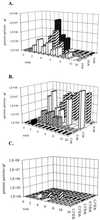Protection against woodchuck hepatitis virus (WHV) infection by gene gun coimmunization with WHV core and interleukin-12
- PMID: 11533170
- PMCID: PMC114475
- DOI: 10.1128/JVI.75.19.9068-9076.2001
Protection against woodchuck hepatitis virus (WHV) infection by gene gun coimmunization with WHV core and interleukin-12
Abstract
Woodchuck hepatitis virus (WHV) and hepatitis B virus (HBV) are closely similar with respect to genomic organization, host antiviral responses, and pathobiology of the infection. T-cell immunity against viral nucleocapsid (HBcAg or WHcAg) has been shown to play a critical role in viral clearance and protection against infection. Here we show that vaccination of healthy woodchucks by gene gun bombardment with a plasmid coding for WHcAg (pCw) stimulates proliferation of WHcAg-specific T cells but that these cells do not produce significant levels of gamma interferon (IFN-gamma) upon antigen stimulation. In addition, animals vaccinated with pCw alone were not protected against WHV inoculation. In order to induce a Th1 cytokine response, another group of woodchucks was immunized with pCw together with another plasmid coding for woodchuck interleukin-12 (IL-12). These animals exhibited WHcAg-specific T-cell proliferation with high IFN-gamma production and were protected against challenge with WHV, showing no viremia or low-level transient viremia after WHV inoculation. In conclusion, gene gun immunization with WHV core generates a non-Th1 type of response which does not protect against experimental infection. However, steering the immune response to a Th1 cytokine profile by IL-12 coadministration achieves protective immunity. These data demonstrate a crucial role of Th1 responses in the control of hepadnavirus replication and suggest new approaches to inducing protection against HBV infection.
Figures



 , animals immunized with pCw plus pIL12w. Mean values at each time point are shown.
, animals immunized with pCw plus pIL12w. Mean values at each time point are shown.
Similar articles
-
Immunization with the gene expressing woodchuck hepatitis virus nucleocapsid protein fused to cytotoxic-T-lymphocyte-associated antigen 4 leads to enhanced specific immune responses in mice and woodchucks.J Virol. 2005 May;79(10):6368-76. doi: 10.1128/JVI.79.10.6368-6376.2005. J Virol. 2005. PMID: 15858020 Free PMC article.
-
Bicistronic woodchuck hepatitis virus core and gamma interferon DNA vaccine can protect from hepatitis but does not elicit sterilizing antiviral immunity.J Virol. 2007 Jan;81(2):903-16. doi: 10.1128/JVI.01537-06. Epub 2006 Nov 1. J Virol. 2007. PMID: 17079319 Free PMC article.
-
Coadministration of gamma interferon with DNA vaccine expressing woodchuck hepatitis virus (WHV) core antigen enhances the specific immune response and protects against WHV infection.J Virol. 2001 Jun;75(11):5036-42. doi: 10.1128/JVI.75.11.5036-5042.2001. J Virol. 2001. PMID: 11333883 Free PMC article.
-
The woodchuck: a model for therapeutic vaccination against hepadnaviral infection.Pathol Biol (Paris). 2010 Aug;58(4):308-14. doi: 10.1016/j.patbio.2010.04.005. Epub 2010 Jun 19. Pathol Biol (Paris). 2010. PMID: 20646874 Review.
-
Therapeutic vaccination in chronic hepatitis B: preclinical studies in the woodchuck model.J Viral Hepat. 2007 Nov;14 Suppl 1:51-7. doi: 10.1111/j.1365-2893.2007.00914.x. J Viral Hepat. 2007. PMID: 17958643 Review.
Cited by
-
Immunization with the gene expressing woodchuck hepatitis virus nucleocapsid protein fused to cytotoxic-T-lymphocyte-associated antigen 4 leads to enhanced specific immune responses in mice and woodchucks.J Virol. 2005 May;79(10):6368-76. doi: 10.1128/JVI.79.10.6368-6376.2005. J Virol. 2005. PMID: 15858020 Free PMC article.
-
Bicistronic woodchuck hepatitis virus core and gamma interferon DNA vaccine can protect from hepatitis but does not elicit sterilizing antiviral immunity.J Virol. 2007 Jan;81(2):903-16. doi: 10.1128/JVI.01537-06. Epub 2006 Nov 1. J Virol. 2007. PMID: 17079319 Free PMC article.
-
Tumor necrosis factor activates a conserved innate antiviral response to hepatitis B virus that destabilizes nucleocapsids and reduces nuclear viral DNA.J Virol. 2007 Jul;81(14):7351-62. doi: 10.1128/JVI.00554-07. Epub 2007 May 2. J Virol. 2007. PMID: 17475655 Free PMC article.
-
Gene therapy for liver diseases: recent strategies for treatment of viral hepatitis and liver malignancies.Gut. 2002 Jan;50(1):130-5. doi: 10.1136/gut.50.1.130. Gut. 2002. PMID: 11772981 Free PMC article. Review.
-
Plasmid interleukin-23 (IL-23), but not plasmid IL-27, enhances the protective efficacy of a DNA vaccine against Mycobacterium tuberculosis infection.Infect Immun. 2006 Jan;74(1):557-65. doi: 10.1128/IAI.74.1.557-565.2006. Infect Immun. 2006. PMID: 16369012 Free PMC article.
References
-
- Ausubel F A, Brent R, Kingston R E, Moore D D, Seidman J G, Smith J A, Struhl K, editors. Current protocols in molecular biology. New York, N.Y: John Wiley and Sons; 2000.
-
- Borrow P. Mechanisms of viral clearance and persistence. J Viral Hepat. 1997;4(Suppl. 2):16–24. - PubMed
-
- Carman W F. The clinical significance of surface antigen variants of hepatitis B virus. J Viral Hepat. 1997;4(Suppl. 1):11–20. - PubMed
-
- Carman W F, Zanetti A R, Karayiannis P, Waters J, Manzillo G, Tanzi E, Zuckerman A J, Thomas H C. Vaccine-induced escape mutant of hepatitis B virus. Lancet. 1990;336:325–329. - PubMed
Publication types
MeSH terms
Substances
LinkOut - more resources
Full Text Sources
Other Literature Sources
Medical

